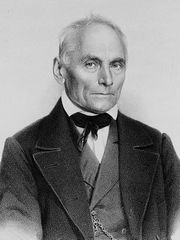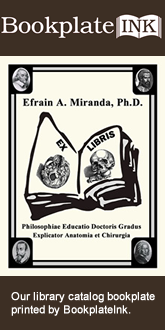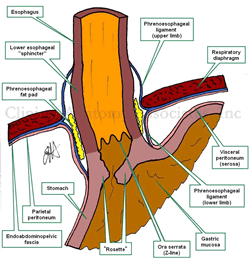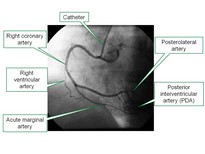
Medical Terminology Daily (MTD) is a blog sponsored by Clinical Anatomy Associates, Inc. as a service to the medical community. We post anatomical, medical or surgical terms, their meaning and usage, as well as biographical notes on anatomists, surgeons, and researchers through the ages. Be warned that some of the images used depict human anatomical specimens.
You are welcome to submit questions and suggestions using our "Contact Us" form. The information on this blog follows the terms on our "Privacy and Security Statement" and cannot be construed as medical guidance or instructions for treatment.
We have 386 guests online

Georg Eduard Von Rindfleisch
(1836 – 1908)
German pathologist and histologist of Bavarian nobility ancestry. Rindfleisch studied medicine in Würzburg, Berlin, and Heidelberg, earning his MD in 1859 with the thesis “De Vasorum Genesi” (on the generation of vessels) under the tutelage of Rudolf Virchow (1821 - 1902). He then continued as a assistant to Virchow in a newly founded institute in Berlin. He then moved to Breslau in 1861 as an assistant to Rudolf Heidenhain (1834–1897), becoming a professor of pathological anatomy. In 1865 he became full professor in Bonn and in 1874 in Würzburg, where a new pathological institute was built according to his design (completed in 1878), where he worked until his retirement in 1906.
He was the first to describe the inflammatory background of multiple sclerosis in 1863, when he noted that demyelinated lesions have in their center small vessels that are surrounded by a leukocyte inflammatory infiltrate.
After extensive investigations, he suspected an infectious origin of tuberculosis - even before Robert Koch's detection of the tuberculosis bacillus in 1892. Rindfleisch 's special achievement is the description of the morphologically conspicuous macrophages in typhoid inflammation. His distinction between myocardial infarction and myocarditis in 1890 is also of lasting importance.
Associated eponyms
"Rindfleisch's folds": Usually a single semilunar fold of the serous surface of the pericardium around the origin of the aorta. Also known as the plica semilunaris aortæ.
"Rindfleisch's cells": Historical (and obsolete) name for eosinophilic leukocytes.
Personal note: G. Rindfleisch’s book “Traité D' Histologie Pathologique” 2nd edition (1873) is now part of my library. This book was translated from German to French by Dr. Frédéric Gross (1844-1927) , Associate Professor of the Medicine Faculty in Nancy, France. The book is dedicated to Dr. Theodore Billroth (1829-1894), an important surgeon whose pioneering work on subtotal gastrectomies paved the way for today’s robotic bariatric surgery. Dr. Miranda.
Sources:
1. "Stedmans Medical Eponyms" Forbis, P.; Bartolucci, SL; 1998 Williams and Wilkins
2. "Rindfleisch, Georg Eduard von (bayerischer Adel?)" Deutsche Biographie
3. "The pathology of multiple sclerosis and its evolution" Lassmann H. (1999) Philos Trans R Soc Lond B Biol Sci. 354 (1390): 1635–40.
4. “Traité D' Histologie Pathologique” G.E.
Rindfleisch 2nd Ed (1873) Ballieres et Fils. Paris, Translated by F Gross
"Clinical Anatomy Associates, Inc., and the contributors of "Medical Terminology Daily" wish to thank all individuals who donate their bodies and tissues for the advancement of education and research”.
Click here for more information
- Details
The "Angle of His" refers to the normally acute angle between the abdominal esophagus and the fundus of the stomach at the esophagogastric junction.
This angle is one of the elements that are important in the prevention of gastroesophageal reflux disease (GERD). When the fundus of the stomach gets expanded by air, because of the normal anatomy and relations of the esophageal hiatus, the esophagogastric junction structures are "pushed" from left to right, pushing close the gastroesophageal flap valve or "rosette". There are other mechanisms that add to the sphincter-like action of the esophagogastric junction structures.
The eponym "angle of His" remembers Dr. Wilhem His Jr. (1864 -1934), a German physician and anatomist, who also described the atrioventricular bundle or "Bundle of His", one of the components of the conduction system of the heart.
Thanks to Debbie Donovan for suggesting this post.
Images property of:CAA.Inc. Artist:Dr. E. Miranda
- Details
The term [coronary dominance] is the answer to the following question: From which coronary artery does the posterior interventricular artery (PDA) arise?
In most of the human species the PDA arises from the right coronary artery, (see accompanying image), therefore most humans (70%) are right dominant. The rest are either left dominant (10%) or have balanced dominance (20%). These statistics have significant variation in different studies.
In the case of balanced dominance, there is either a double posterior interventricular artery, where one is a branch of the right coronary artery and the other a branch of the left coronary artery, or a single PDA receiving blood supply from both coronary arteries.
Coronary dominance is important because the interventricular septum receives blood supply from the PDA in its posterior 1/3rd. If the heart is left dominant, all the blood supply of the interventricular septum is dependant on the left coronary artery. In this case, blockage of the left coronary artery can be catastrophic!
There can be interesting anatomical variations in the coronary arteries of the heart. For a detail on these anatomical variations, click here. Heart and coronary artery anatomy is one of the many lecture topics presented by CAA, Inc
Image property of:CAA.Inc.. Artist:Victoria G. Ratcliffe
- Details
This is a word of Greek origin. The prefix [a-) means "absence of", or "without". The root term [-phon-] means "sound" or "voice". Aphonia is a pathological absence of voice, and was used by both Hippocrates and Galen.
Do not confuse [aphonia] with [dysphonia], where the prefix [dys-] means "abnormal". In aphonia there is total absence of voice, whereas in dysphonia there is an abnormal voice or "hoarseness"
As a side note, the word [phonograph] arises from the combination of the root terms [-phon-] and [-graph-], which means "to write". The word [phonograph] does not relate to the playing of a record, but rather to the process of creating one, transforming sound into a wavy line etched on a rotating wax model that is later cast into records. The modern production of sound CD's is similar, where the sound waves are act upon a laser that "burns" the track into a master CD. It is a similar process, but I guess calling creating a CD a type of "phonography" is too old fashion for modern marketing!
- Details
This article is part of the series "A Moment in History" where we honor those who have contributed to the growth of medical knowledge in the areas of anatomy, medicine, surgery, and medical research.

Jan Evangelista Purkinje
Jan Evangelista Purkinje (1787 - 1869). Known by his German name Purkinje, or his Czech name, Purkyn?, as well as his church-given name Salverius. Purkinje was born in the city of Libochovice, Bohemia, (now Czechoslovakia). He started his early studies in the church with Piarist monks. He took the name of Brother Salverius and served as a teacher in the Piarist schools. He dedicated himself to the study of natural sciences. Purkinje left the monastery before taking his final vows. Purkinje continued his studies and graduated in medicine in Prague. Even as a student Purkinje started research on the physics of sound and the physiology of vision, which he continued after his graduation. Purkinje was one of the first to understand the vision of motion, thus creating the first animated cartoons!
In 1823 Purkinje was appointed Professor of Physiology at the University of Wroclaw (Breslau), later taking the same chair in Prague. Besides being one of the first to propose experimental physiology as basis for research, Purkinje was one of the first to use the microscope to study the cells of the body, proposing the "cell theory", and introducing the word "protoplasm".
He made a number of discoveries, and his name is eponymically tied to many structures and processes, such as:
- Purkinje's cell of the cerebellum: Piriform cells found in Purkinje's layer
- Purkinje's fibers of the heart: These are not "fibers" as the name implies, but fast-conducting myocardial cells found as the most distal components of the conduction system of the heart
- Purkinje's law of vertigo: An observation that the apparent motion perceived when stopping the head after rotation changes from horizontal to vertical if the head is inclined laterally. This is important to pilots, as they are trained to understand that in conditions without external reference, moving the head down or laterally can induce uncontrollable vertigo.
Sources:
1. "Purkinje JE (1845) Mikroskopisch-neurologische Beobachturgen" Arch Anat Physiol Wiss Med II/III:281-295
2. "Jan Evangelista Purkinje (1787-1869)" J Neurol Neurosurg Psychiatry. 1994 July; 57(7): 777
3. "Jan Evangelista Purkinje (1787-1869)" Davies, MK; Hollman A. Heart (1996) 76(4): 311
- Details
The root term [-angi-] has Greek origins and means "vessel", as in a "container". The suffix [(o)gram] means "examination of", or a "record". An angiogram is the examination of a vessels using some type of viewing or recording device.
In an angiogram the physician will inject radiopaque contrast to make the vessels discernible in an X-ray machine.
The accompanying image is an angiogram of the right coronary artery. It can also be called a "coronariogram".
The image shows the right coronary artery and three key branches: the acute marginal artery, the posterolateral artery, and the posterior interventricular artery (PDA).
- Details
The "acute margin" refers to the anteroinferior border of the heart. It is also known by its Latin name [margo acutus].
The name of this border or margin of the heart is quite descriptive. If you observe the angle formed between the anterior or sternocostal surface of the heart with the posterior or diaphragmatic surface of the heart, you can see that the angle between these two surfaces is less than 90 degrees, therefore an "acute" angle. The corresponding border between these two surfaces has to be called the "acute margin"!
In relation to the acute margin of the heart there is usually found one of the longest branches of the right coronary artery. This artery that runs alongside the acute margin, is the "acute marginal artery", In an angiogram, this artery clearly depicts the anteroinferior border of the heart.
Here is a link to the article on the "obtuse margin" of the heart.



![Coronary Arteries. Coronary Arteries. The [*] indicates the left coronary artery](/images/MTD/SmallImages/coronaryarterieslabels_sm.jpg)

